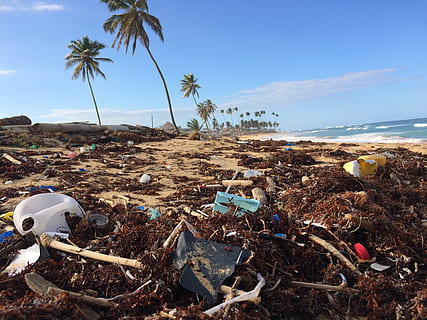OCEAN MATERIAL | MAR 01ST 2022 | 14 MINS
10 Scientific Solutions to Plastic Pollution
Plastic pollution is leaving behind impacts for generations to come. If our current rate of pollution continues, experts predict there will be more plastic than fish in the ocean by 2050. It is clear that we urgently need solutions to tackle this pressing issue. Thanks to innovation and research, scientists have pioneered groundbreaking technologies to help collect and prevent plastic pollution. Here are 10 scientific solutions to plastic pollution.

–
Plastic pollution is one of the most pressing environmental challenges the world faces today. Because most plastics don’t break down and dissolve easily, they slowly accumulate in our oceans and will take centuries to disintegrate, posing tremendous risks for aquatic life, human health and marine ecosystems. Studies have estimated that by 2050, there will be more plastic in the sea than fish.
The world’s rivers, oceans and seas have become convenient transport vectors and dumping sites for plastic waste generated by human activity. This pollution comes at a huge cost – from cleanup and repair efforts to the loss of tourism revenue and the societal impacts of degraded environments.
Around 300 million tonnes of plastic are produced worldwide each year, yet only about half of this is recycled. Some believe that simply reducing plastic use will solve the problem. However, this does not address the plastic already polluting the ocean, and current policies have not proven effective – in fact, production is still increasing and projected to keep climbing.
But all hope is not lost. While individuals can make a difference by reducing plastic consumption, science and technology are helping us push the boundaries of what’s possible. Collective action is essential. In 1987, the Montreal Protocol was introduced to prevent further damage to the ozone layer. Over time, humanity phased out over 98% of harmful substances, preventing an estimated 2 million cases of skin cancer. If we could unite then, we can unite now to tackle plastic pollution.
1. The Ocean Cleanup
The Ocean Cleanup is a prime example of collective action. Inspired by a scuba diving trip in Greece, Dutch CEO Boyan Slat created the organisation to collect plastic from the Great Pacific Garbage Patch. Using the System 001 – 600-meter-long floating structures designed to capture marine debris, including microplastics – the system relies on wind and ocean currents to gather waste. Once collected, the plastic is transported back to land for recycling.
The goal is to deploy the system in the world’s five major garbage patches and remove 50% of the plastic in the Great Pacific Garbage Patch within five years.
2. NASA Satellite Technology
NASA’s Cyclone Global Navigation Satellite System (CYGNSS), originally designed to monitor hurricanes, can detect concentrations of microplastic by measuring the ocean’s surface roughness. This groundbreaking method, developed in 2016, is a vital tool for tracking and managing ocean plastic pollution. It will also help research the impacts of microplastics, support nonprofit cleanup efforts, and protect marine life.
3. Ocean Material®
Ocean Material® empowers coastal collector communities by creating effective, responsible supply chains. By working directly with these communities to source ocean plastic waste and transform it into high-quality materials for products like furniture, clothing, and packaging, Ocean Material® promotes sustainable livelihoods and supports local economies. Their commitment to fair compensation and responsible sourcing ensures minimal environmental impact.
4. Plastic-Eating Enzymes
In Japan in 2016, scientists discovered a plastic-eating enzyme capable of breaking down PET (polyethylene terephthalate). Ideonella Sakaiensis 201-F6 secretes PETase, breaking PET into carbon for energy. Though slow, scientists have since modified this enzyme to degrade PET 20% faster.
5. Plastic-Eating Mushrooms – Biohm
The fungus Aspergillus tubingensis can degrade polyurethane. Biohm’s lead biotech engineer Samantha Jenkins found it consuming the plastic sponge used to seal it. As it digests plastic, the fungus proliferates, potentially producing biomaterials for food, feedstock, or antibiotics.
6. Magnetic Nanocoils
Experimental magnetic nanocoils can target and break down ocean microplastics without harming marine life. Coated in nitrogen and manganese, these coils react with oxygen to attack plastic. Early experiments show 30–50% reduction rates over eight hours.
7. Licella Holdings – Cat-HTR Technology
Australian company Licella Holdings developed the Catalytic Hydrothermal Reactor (Cat-HTR), which uses high pressure and heat to break down mixed plastics into oils, waxes, and reusable plastics. While versatile, critics warn the process could produce further carbon emissions.
8. PlasticRoad
The PlasticRoad project in the Netherlands built bike paths and roads using 70% recycled plastic. More durable than asphalt and faster to install, these roads have a smaller carbon footprint and demonstrate circular design principles.
9. Evoware
Indonesian startup Evoware transforms seaweed into edible and dissolvable bioplastic packaging. Though promising, production is more costly than conventional plastics, and some packaging still uses additional plastic or paper layers.
10. Nicholas Institute – Plastic Technology Inventory
The Nicholas Institute catalogued 52 technologies to prevent or collect plastic pollution, including Germany’s Plastic Fischer Trash Boom and Canada’s Hoola One vacuum system. Their research emphasizes that prevention and collection are both urgent priorities.
Conclusion
Plastic Pollution is a monumental global issue – but with science, innovation, and collective will, we can transform the tide. Solutions exist. Now is the time to scale them.
Explore more:
- Discover our recycled materials
- Learn about our mission
- 🇩🇪 Lesen Sie diesen Artikel auf Deutsch
- 🇨🇳 阅读中文版
01.03.2022
